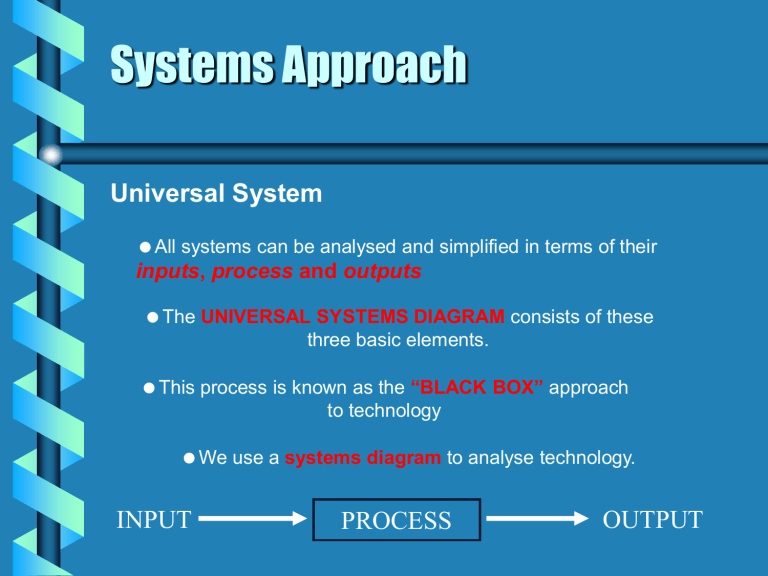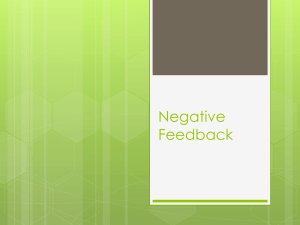Systems and Control

Systems Approach
Universal System
All systems can be analysed and simplified in terms of their
inputs, process and outputs
The UNIVERSAL SYSTEMS DIAGRAM consists of these three basic elements.
This process is known as the “BLACK BOX” approach to technology
We use a systems diagram to analyse technology.
INPUT PROCESS OUTPUT
Systems Diagrams
To analyse a system more fully, we can list the inputs and outputs from the system.
As an example, consider an electric kettle,
INPUTS:
Water and
Electricity.
OUTPUTS: Hot water, noise, steam.
Water and
Electricity
KETTLE
Hot water,
Noise and
Steam
Pupil Problems
Here are some problems for you to try,
1) Battery powered torch
Chemical energy
Torch
2) Vacuum cleaner
Electrical energy
Dirt
Vacuum
Light energy
Heat energy
Noise, Heat,
Clean carpets
Pupil Problems
3) Washing machine
Water, Dirty clothes,
Electrical energy
Washing M/C
4) Television
Electrical energy,
Digital signal
TV
Hot water,
Noise,
Steam,
Clean clothes
Picture,
Sound,
Heat
Sub-Systems
Sometimes it is necessary to break the PROCESS down into smaller pieces.
To enable this we consider the system’s
SUB SYSTEMS
System
Boundary
Example: A battery powered torch
Chemical energy
Switch Bulb
Light and
Heat energy
Pupil Problems
1) A microwave oven
1 st Inputs
Set time
Timer
2 nd Subsystems
5 th outputs
Magnetron
Electrical energy
On/Off Turntable
3 rd Boundary
Food
4 th Flow of information arrows
Heat,
Light,
Hot food
Pupil Problems
2) Washing machine
Electrical energy
Water
Set Cycle
Control
Heater Motor
Drum
Pump
Hot water,e tc.
Clean
Clothes
Dirty clothes
Control Systems
All types of system need some form of control to operate
There are 2 main types of control,
OPEN LOOP and CLOSED LOOP
In an OPEN LOOP system the input causes the output
The output operates independently of the input
Open loop system are cheap but not very accurate
Action Light switch Bulb Light
Control Systems
In a CLOSED LOOP system, the output is compared with a reference value
Closed loop systems are more accurate, but also more expensive
The self monitoring action of closed loop is achieved through a FEEDBACK loop
Set temp
Thermostat
On/Off Motor Fan Heater
Elect
Heat
Control Systems
Manual Open Loop
Water
Person
Tap
Handle
Valve Water level
Flood
Control Systems
Manual Closed Loop
Water
Tap
Handle
Valve
Correct level
Water level
Hand
Eyes /
Brain
Control Systems
Press
Automatic Closed Loop
Water
Start
Switch
Valve
Correct level
Water level
Control
Unit
Level
Sensor
•
•
•
Pupil Problems
State three examples of manual open-loop control. Draw a system diagram for each one and show the system boundary.
State three examples of manual closed-loop control. Draw a system diagram and show the system boundary.
State three examples of automatic closed-loop control. Draw a system diagram and show the system boundary.
Control Diagrams
Example: Temperature control in a gas oven
We could draw a systems diagram for the gas oven, but it is sometimes necessary to draw a more accurate control diagram
Gas Valve Burner Set value
+
-
Temperature sensor
Oven
Actual value
Correct temperature
Error Detector Symbol
How the error detector works:
If SET VALUE (+) is bigger than the ACTUAL VALUE
(-) the ERROR SIGNAL is ON (Raising the oven temperature)
Set value
+
If the SET VALUE (+) is less than the ACTUAL VALUE (-) the
ERROR SIGNAL is OFF (Cooling the oven temperature)
-
Actual value
Error
Pupil Problems
(1) Explain the following terms when applied to control systems:
• Open loop
• Closed loop
•
Error detector
Pupil Problems
(1) Draw a control diagram showing the manual closed-loop control system for a cyclist steering a bicycle.
(1) Draw a control diagram showing the automatic closed-loop control system for the cruise-control in a car.





